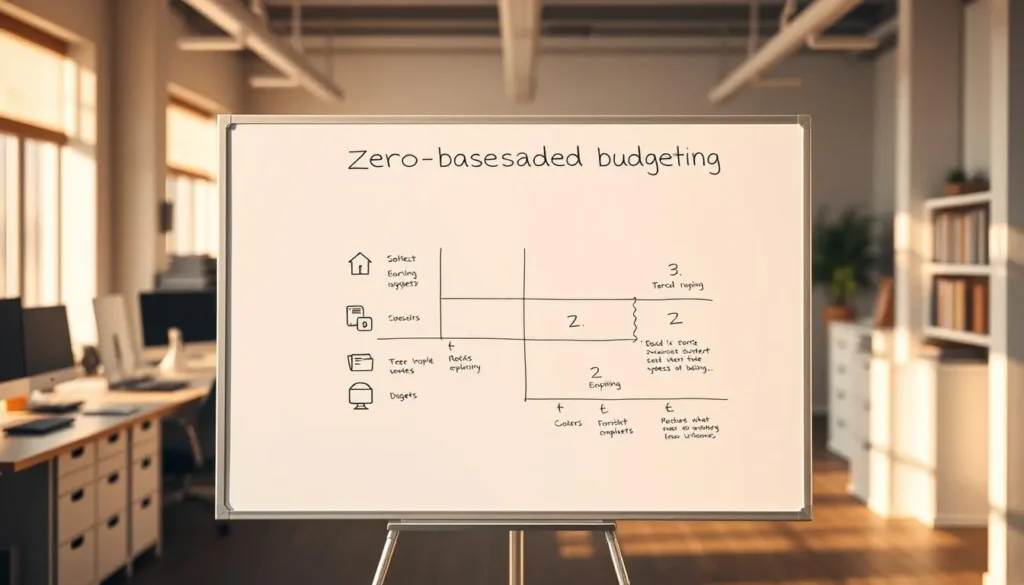Zero-Based Budgeting: 5 Powerful Steps to Financial Freedom
Did you know that nearly 40% of Americans can’t cover a $400 emergency expense? This staggering statistic highlights the importance of effective financial planning. A well-structured Budgeting strategy can be the key to financial stability.

Zero-based budgeting is an approach that has gained popularity for its straightforward and efficient method of managing finances. By starting from a “zero base,” every dollar is accounted for, ensuring that financial resources are allocated effectively.
Table of Contents
What Is Zero-Based Budgeting?
The concept of zero-based budgeting revolves around starting from a ‘zero base,’ where every expense must be justified anew each period. This approach to financial management has gained popularity due to its effectiveness in cost management and Expense tracking.
The Core Concept of Starting from Zero
Zero-based budgeting begins with a “zero balance,” meaning that every dollar must be allocated towards expenses, savings, or investments. This method ensures that every financial resource is justified and utilized effectively.
Historical Background and Development
Originally developed in the 1970s by Peter Pyhrr, zero-based budgeting was initially used in corporate settings to optimize resource allocation. According to Investopedia, its success in the business world led to its adaptation for personal finance management.
The “Give Every Dollar a Job” Philosophy
At the heart of zero-based budgeting is the philosophy of “giving every dollar a job.” This means that every dollar is assigned a purpose, whether it’s for bills, savings, or discretionary spending. By doing so, individuals can ensure that their financial resources are being used efficiently, as emphasized in these Budgeting tips.
| Budgeting Aspect | Traditional Budgeting | Zero-Based Budgeting |
|---|---|---|
| Starting Point | Previous period’s budget | Zero |
| Expense Justification | Increments based on previous budget | Every expense must be justified |
As noted by financial expert Dave Ramsey, “A budget is telling your money where to go instead of wondering where it went.” This quote encapsulates the essence of zero-based budgeting, emphasizing the importance of intentional financial planning.
How Zero-Based Budgeting Differs from Traditional Budgeting Methods
Zero-based budgeting offers a distinct approach to managing finances compared to traditional budgeting methods, focusing on assigning every dollar a job. This fundamental difference in approach is rooted in the philosophy and mechanics of each Budgeting strategy.
Traditional Incremental Budgeting vs. Zero-Based Approach
Traditional incremental budgeting involves making small adjustments to the previous period’s budget, often based on historical spending patterns. In contrast, zero-based budgeting starts from a “zero base,” where every expense must be justified anew each period. This means that each dollar is accounted for, and there’s a clear understanding of where the money is going—something that Budgeting tips can help you implement more effectively
To illustrate the difference, consider the following comparison:
| Budgeting Aspect | Traditional Incremental Budgeting | Zero-Based Budgeting |
|---|---|---|
| Starting Point | Previous period’s budget | Zero base |
| Expense Justification | Increments based on past spending | Every expense justified anew |
| Financial Control | Limited visibility into expenses | High visibility and control |
Key Philosophical Differences
The philosophy behind zero-based budgeting is centered on fiscal responsibility and the belief that every dollar should be working towards a specific financial goal. As Dave Ramsey, a well-known personal finance expert, once said,
“A budget is telling your money where to go instead of wondering where it went.”
This philosophy is at the heart of zero-based budgeting, emphasizing intentionality and control over one’s finances.
Comparing Outcomes and Effectiveness
When comparing the outcomes of traditional and zero-based budgeting, the latter often yields more effective financial management. By ensuring that every dollar is assigned a purpose, individuals and organizations can better achieve their financial goals. The table below summarizes the key outcomes:
| Outcome | Traditional Budgeting | Zero-Based Budgeting |
|---|---|---|
| Financial Discipline | Variable | High |
| Expense Management | Often reactive | Proactive |
| Goal Achievement | Less focused | Highly focused |
In conclusion, the differences between zero-based and traditional budgeting methods are significant, with zero-based budgeting offering a more controlled and intentional approach to financial management. By understanding these differences, individuals can make informed decisions about their budgeting strategy and move towards greater fiscal responsibility.
The Benefits of Zero-Based Budgeting
Zero-based budgeting offers numerous benefits, including enhanced financial control and the elimination of unnecessary expenses. By adopting this approach, individuals can gain a clearer understanding of their financial situation, making it easier to manage their money effectively.
Enhanced Financial Control and Visibility
One of the primary advantages of zero-based budgeting is that it provides a detailed and accurate picture of one’s financial standing. This method ensures that every dollar is accounted for, giving individuals greater control over their financial resources. As a result, they can make more informed decisions about their spending and savings, especially when supported by smart Budgeting tips.
A notable example of the effectiveness of zero-based budgeting is its adoption by large corporations. According to a report by Deloitte, companies that implemented zero-based budgeting saw significant improvements in their financial management. As
“Zero-based budgeting is a disciplined process that can lead to significant cost savings and improved operational efficiency.”
This philosophy can be applied to personal finance as well, leading to better financial health.
Elimination of Unnecessary Expenses
Zero-based budgeting helps in identifying and eliminating unnecessary expenses. By scrutinizing every expense and requiring justification for each dollar spent, individuals can cut down on wasteful expenditures. This process involves categorizing expenses and evaluating their necessity, leading to a more streamlined and efficient allocation of resources.
Alignment with Financial Goals
This budgeting method also facilitates alignment with long-term financial goals. By assigning a purpose to every dollar, individuals can ensure that their spending is in line with their financial objectives. Whether it’s saving for a major purchase, paying off debt, or building wealth, zero-based budgeting helps in creating a roadmap for achieving these goals.
Short-Term Financial Improvements
In the short term, zero-based budgeting can lead to improved cash flow management and reduced financial stress. By closely monitoring income and expenses, individuals can avoid overspending and make timely adjustments to their budget.
Long-Term Wealth Building
Over the long term, the disciplined approach of zero-based budgeting can contribute to wealth building. By consistently allocating funds towards savings and investments, individuals can accumulate wealth over time. A table illustrating the potential long-term benefits is provided below:
| Year | Annual Savings | Total Savings |
|---|---|---|
| 1 | $5,000 | $5,000 |
| 2 | $5,500 | $10,500 |
| 3 | $6,000 | $16,500 |
As shown in the table, consistent savings can lead to substantial total savings over a few years, demonstrating the potential of zero-based budgeting for long-term financial success.
Who Should Use Zero-Based Budgeting?
Determining the ideal candidate for zero-based budgeting requires an examination of financial objectives and spending habits. This budgeting method is particularly effective for individuals and businesses seeking to optimize their budget allocation and closely monitor expense tracking.
Ideal Candidates for This Budgeting Strategy
Zero-based budgeting is most beneficial for those who need a high level of financial control and are willing to dedicate time to managing their finances. It’s ideal for individuals with variable incomes or expenses, as it allows for flexibility in budget allocation.
When Traditional Budgeting Might Be Better
For those with very straightforward, fixed expenses and incomes, traditional budgeting methods might be more straightforward and less time-consuming. However, for those seeking detailed insights into their spending, zero-based budgeting offers superior expense tracking capabilities.
Adapting the Method to Different Financial Situations
Zero-based budgeting can be adapted to various financial situations by adjusting budget categories and priorities. This flexibility makes it a versatile tool for managing finances effectively, regardless of income level or financial goals.
Essential Tools and Resources for Zero-Based Budgeting
Implementing zero-based budgeting effectively requires the right tools and resources. With the variety of options available, individuals can choose the methods that best fit their financial management needs and preferences.
Digital Tools and Apps
Digital tools have revolutionized the way we manage our finances. For zero-based budgeting, several digital options are available:
Budgeting Software Options
Budgeting software like YNAB (You Need a Budget) and Mint offer comprehensive features that help track expenses, create budgets, and set financial goals. These platforms provide a clear picture of one’s financial situation and help in making informed decisions.
Mobile Apps for On-the-Go Management
Mobile apps such as Personal Capital and PocketSmith allow users to manage their budgets on the go. These apps offer features like expense tracking, investment monitoring, and bill reminders, making it easier to stick to a zero-based budget.
Spreadsheet Templates and Systems
For those who prefer a more hands-on approach, spreadsheet templates can be a powerful tool. Programs like Microsoft Excel or Google Sheets offer customizable templates that can be tailored to fit individual budgeting needs.
Physical Tracking Methods
Some individuals may prefer physical methods for tracking their budget, such as using a planner or notebook. This approach can be particularly useful for those who like to have a tangible record of their financial transactions. Learn more about budgeting methods to find what works best for you.
Regardless of the method chosen, the key to successful zero-based budgeting is consistency and regular monitoring. By leveraging the right tools and resources, individuals can effectively manage their finances and achieve their financial goals.
| Tool Type | Examples | Key Features |
|---|---|---|
| Budgeting Software | YNAB, Mint | Expense tracking, budget creation, financial goal setting |
| Mobile Apps | Personal Capital, PocketSmith | On-the-go expense tracking, investment monitoring, bill reminders |
| Spreadsheet Templates | Microsoft Excel, Google Sheets | Customizable budgeting templates |
| Physical Tracking | Planners, Notebooks | Tangible record-keeping, manual budgeting |
Step-by-Step Guide to Implementing Zero-Based Budgeting
The journey to financial clarity through zero-based budgeting starts with a simple yet crucial step: calculating your monthly income. This foundational step sets the stage for a successful budgeting process.
Step 1: Calculate Your Monthly Income
Understanding your monthly income is the cornerstone of zero-based budgeting. It’s essential to have a clear picture of how much money you have coming in each month.
Handling Regular Income
If you have a regular income, calculating your monthly income is straightforward. You simply need to identify your monthly take-home pay.
Accounting for Variable Income
For those with variable income, such as freelancers or commission-based workers, calculating monthly income requires averaging earnings over a few months or using the lowest expected income for a conservative estimate.
Step 2: List All Your Expenses and Financial Goals
Next, you need to catalog all your expenses and financial goals. This includes fixed expenses like rent and utilities, variable expenses like groceries and entertainment, and savings goals.
- Fixed Expenses: Rent, utilities, insurance
- Variable Expenses: Groceries, dining out, entertainment
- Savings Goals: Emergency fund, retirement savings, other savings objectives
Step 3: Assign Every Dollar a Purpose
With your income and expenses outlined, the next step is to assign every dollar a job. This means allocating your income towards your expenses and savings goals until you reach zero.
Every dollar should be accounted for, ensuring that you’re making the most of your money.
Step 4: Track and Adjust Throughout the Month
Tracking your spending throughout the month is crucial. It allows you to stay on top of your budget and make adjustments as needed.
Regular monitoring helps in avoiding overspending and ensures you’re on track to meet your financial goals.

Step 5: Review and Improve for Next Month
At the end of the month, review your budget’s performance. Identify areas for improvement and adjust your budget accordingly for the next month.
- Review your spending and savings
- Adjust your budget as needed
- Plan for upcoming expenses or changes in income
By following these steps, you can effectively implement zero-based budgeting and take control of your financial planning and money management.
Creating Effective Budget Categories for Zero-Based Budgeting
To maximize the benefits of zero-based budgeting, creating effective budget categories is essential. This process involves identifying and categorizing expenses, savings, and investments in a way that aligns with your financial goals.
Essential Fixed Expense Categories
Fixed expenses are regular, non-discretionary costs that remain relatively constant from month to month. Essential categories include housing, utilities, and minimum payments on debts. Allocating funds to these categories ensures that your basic needs are met. Explore more on managing fixed expenses effectively.
Variable Expense Categories
Variable expenses can fluctuate significantly from one month to another. Categories such as groceries, entertainment, and travel fall under this heading. Accurately budgeting for these expenses requires tracking past spending patterns.
Savings and Investment Categories
A crucial aspect of zero-based budgeting is allocating funds towards savings and investments. This includes emergency funds, retirement savings, and other investment vehicles. Prioritizing these categories helps in building financial security.
Customizing Categories for Your Lifestyle
While standard categories provide a foundation, it’s essential to tailor your budget categories to fit your specific needs and lifestyle. This might involve creating categories for pet expenses, hobbies, or home maintenance. Customization enhances the effectiveness of your budget.
By thoughtfully creating and managing budget categories, individuals can achieve better fiscal responsibility and make progress towards their financial goals. Effective budget allocation and expense tracking are key to the success of zero-based budgeting.
Common Challenges in Zero-Based Budgeting and How to Overcome Them
The journey to effective zero-based budgeting involves navigating common pitfalls that can derail your financial plans. As you adopt this disciplined approach to financial planning, you’ll likely face several challenges. Understanding these obstacles and how to overcome them is crucial for maintaining your budgeting discipline.
Dealing with Irregular Income
One of the primary challenges is managing irregular income. For individuals with variable incomes, assigning every dollar a job can be daunting. To overcome this, consider averaging your income over several months to create a stable budget baseline. You can also prioritize essential expenses and allocate funds accordingly.
Managing Unexpected Expenses
Unexpected expenses can disrupt even the most carefully crafted budget. To mitigate this, build a buffer into your budget for emergencies. This could involve setting aside a small percentage of your income each month in an easily accessible savings account.

Staying Motivated and Consistent
Maintaining motivation is crucial for the long-term success of zero-based budgeting. Regularly reviewing your financial goals and celebrating small victories can help keep you on track. Additionally, finding a budgeting buddy or joining a financial community can provide support and encouragement.
Handling Budget Shortfalls
Despite careful planning, budget shortfalls can occur. When they do, it’s essential to have strategies in place to manage them. This involves identifying areas where you can cut back on non-essential expenses and reallocating those funds to cover essential costs.
Emergency Fund Strategies
Building an emergency fund is a critical component of managing budget shortfalls. Aim to save three to six months’ worth of expenses in a readily accessible account. This fund will help you navigate unexpected expenses without derailing your budget.
Temporary Adjustments vs. Long-Term Changes
When faced with a budget shortfall, it’s essential to distinguish between temporary adjustments and long-term changes. Temporary measures might include reducing discretionary spending or using savings. Long-term changes, however, might involve adjusting your budget categories or exploring ways to increase your income.
By understanding these common challenges and implementing strategies to overcome them, you can maintain the discipline required for successful zero-based budgeting. Effective cost management and money management practices will help you achieve your financial goals and improve your overall financial health.
Zero-Based Budgeting for Businesses and Organizations
The principles of zero-based budgeting can be effectively adapted for corporate use, offering businesses a robust budgeting strategy that enhances fiscal responsibility.
Adapting the Principles for Corporate Use
In a business context, zero-based budgeting involves a thorough examination of every expense, ensuring that each dollar is allocated towards a specific purpose. This approach helps organizations eliminate unnecessary costs and optimize their budget allocation.
Implementation Strategies for Teams
To successfully implement zero-based budgeting, businesses should start by setting clear financial goals and involving all relevant teams in the budgeting process. This collaborative approach ensures that everyone is aligned with the company’s financial objectives.
Measuring ROI and Effectiveness
The effectiveness of zero-based budgeting in businesses can be measured by tracking key performance indicators (KPIs) such as cost savings, improved financial transparency, and enhanced operational efficiency. Regular review and adjustment of the budget are crucial to achieving the desired outcomes.
Real-Life Success Stories and Case Studies
By applying zero-based budgeting, many have experienced remarkable improvements in their financial management and planning. This approach has enabled individuals and businesses to achieve significant financial goals, from debt elimination to wealth building.
Individual Success Stories
Numerous individuals have benefited from adopting zero-based budgeting. For instance, some have successfully eliminated debt by allocating every dollar towards financial goals.
Debt Elimination Examples
One notable example is a family who managed to pay off their mortgage early by strictly adhering to a zero-based budget, allocating surplus funds towards their loan.
Wealth Building Journeys
Others have used zero-based budgeting to build wealth. By prioritizing savings and investments, individuals have achieved financial independence.

Business Transformation Examples
Businesses have also seen significant transformations through zero-based budgeting. By scrutinizing every expense, companies have streamlined operations and improved profitability.
Lessons Learned from Failed Implementations
Not all zero-based budgeting implementations are successful. Common pitfalls include failing to regularly review and adjust budgets, and not accounting for all expenses. Learning from these mistakes can help improve the effectiveness of zero-based budgeting.
These real-life examples illustrate the potential of zero-based budgeting to transform financial management for both individuals and businesses. By understanding the successes and challenges, readers can better apply these principles to their own financial planning.
Conclusion: Is Zero-Based Budgeting Right for You?
As you’ve explored the concept of zero-based budgeting, it’s essential to assess whether this budgeting strategy aligns with your financial goals and money management needs. By now, you’ve seen how zero-based budgeting can enhance fiscal responsibility and provide a clear picture of your financial situation.
Implementing zero-based budgeting requires discipline and a thorough understanding of your income and expenses. While it offers numerous benefits, such as eliminating unnecessary expenses and aligning your spending with your financial objectives, it also presents challenges, like managing irregular income or unexpected expenses.
To determine if zero-based budgeting is right for you, consider your financial situation, goals, and ability to track and adjust your spending regularly. If you’re willing to dedicate the necessary time and effort, this budgeting strategy can be a powerful tool for achieving financial stability and success.
By adopting a zero-based budgeting approach, you’ll be taking a significant step towards improving your money management skills and fostering a culture of fiscal responsibility. Evaluate your financial needs, and consider giving zero-based budgeting a try to see the positive impact it can have on your financial well-being.
FAQ
What is the primary goal of zero-based budgeting?
The primary goal of zero-based budgeting is to assign every dollar a job, ensuring that every expense is justified and aligned with financial goals, thereby optimizing financial management and cost control.
How does zero-based budgeting differ from traditional budgeting methods?
Zero-based budgeting differs from traditional budgeting methods in that it starts from a “zero base,” requiring every expense to be justified anew each period, rather than starting from a previous budget and making adjustments.
What are the key benefits of implementing zero-based budgeting?
The key benefits of implementing zero-based budgeting include enhanced financial control and visibility, elimination of unnecessary expenses, and better alignment with financial goals, leading to improved fiscal responsibility and money management.
Who can benefit from using zero-based budgeting?
Individuals, businesses, and organizations seeking to improve their financial management and achieve their financial goals can benefit from using zero-based budgeting, particularly those looking to optimize their budget allocation and expense tracking.
What tools are available for implementing zero-based budgeting?
Various digital tools, including budgeting software and mobile apps, as well as spreadsheet templates and physical tracking methods, are available to support the implementation of zero-based budgeting, facilitating effective cost management and financial planning.
How can one handle irregular income when using zero-based budgeting?
Handling irregular income when using zero-based budgeting involves prioritizing essential expenses, creating a budget based on average income, and regularly reviewing and adjusting the budget to accommodate fluctuations in income.
What are some common challenges faced when implementing zero-based budgeting?
Common challenges faced when implementing zero-based budgeting include managing irregular income, dealing with unexpected expenses, staying motivated, and handling budget shortfalls, which can be addressed through strategies like emergency fund strategies and temporary adjustments.
Can zero-based budgeting be adapted for business use?
Yes, zero-based budgeting can be adapted for business use by applying its principles to corporate financial management, involving the adaptation of budgeting processes, implementation strategies for teams, and measuring ROI and effectiveness.




